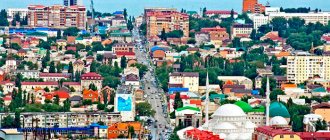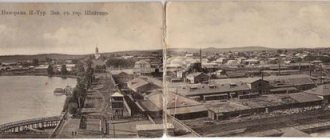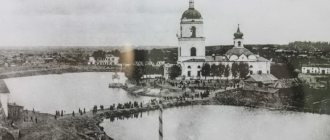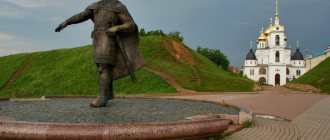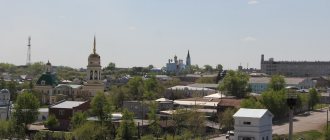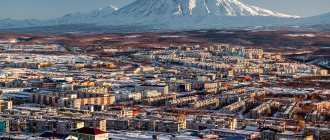The city of Kamyshlov is located on the banks of the Pyshma River, at the mouth of its tributary Kamyshlovka. It is 135 kilometers away from Yekaterinburg. In terms of population, this is a small town with a population of about 26 thousand people, but it is a culturally and historically amazing settlement in Russia. The city of Kamyshlov, Sverdlovsk region, is an ancient city founded in 1668. What is his history and fate? How does the city live now? Which of its attractions have survived to this day?
Origin of the name
There is a legend about the origin of the name of the city, which tells that a highway once passed through the city of Kamyshlov. The city was located in the valley of the Pyshma River, where a lot of reeds grew. The prisoners were driven along the highway, and when they saw a happy opportunity in the form of reed thickets, as soon as they approached the city, they escaped and hid in the reeds. The guards were forced to catch them in these thickets, that is, it turned out to be fishing in the reeds, since then the settlement was nicknamed “Kamyshlov”.
Geographical location of Kamyshlov
The city of Kamyshlov is located in the southeast of the Sverdlovsk region in the zone of the vast forest-steppe Trans-Urals, on the left bank of the Pyshma River, east of the regional center the city of Yekaterinburg. The distance to the city of Yekaterinburg is 143 km, to the city of Moscow - 1956 km.
The city of Kamyshlov occupies a favorable transport and geographical position on the Yekaterinburg-Tyumen railway and the Yekaterinburg-Tyumen federal highway, providing its external connections. The entire border of the municipal formation “Kamyshlov city” runs with the municipal formation “Kamyshlovsky district”.
The total area of the territory of the municipal formation “city of Kamyshlov” is 5175 hectares. The forests are predominantly coniferous - pine. Rivers: Pyshma, Kamyshlovka. Minerals: diatomaceous clay.
The roads connecting the city of Kamyshlov with neighboring settlements have an asphalt concrete surface.
In the northern and southern directions of the city of Kamyshlov there are roads: Kamyshlov - Irbit, Kamyshlov - Shadrinsk.
Historical sketch
The city of Kamyshlov was founded in 1668, when a fort was built here to protect against attacks by nomads. A small settlement soon formed around the fort, initially called Kamyshlovskaya Sloboda.
Since 1781, the settlement became a district town of the Yekaterinburg region.
In 1856, the city had one church, 335 houses, and 45 shops.
By the end of the 19th century, it became a merchant's area, and there were already about 20 shops selling bread and bakery products. There was a distillery, a tannery and a candle factory, and there were four mills. A district and religious school, a women's gymnasium, a library, a printing house, an icon-painting workshop, and five churches were built. The city hosted two large fairs - Pokrovskaya and Tikhonovskaya.
In 1885, a railway was built through the city of Kamyshlov.
During the Great Patriotic War, new production enterprises were opened in Kamyshlov: a bakery, a mechanical repair plant.
In February 1946, the city of Kamyshlov was separated from the Sverdlovsk region of the Kamyshlovsky district and classified as a city of regional subordination.
In the post-war period, a garment factory, metalworking and electrical plants were built here.
Born in the city: Naumov A. - historian, Gridnev P. - breeder, Shchipachev S. - poet.
Kamyshlov
(Sverdlovsk region)
OKATO code:
65440
Founded:
1668
City since:
1781 City of regional subordination
Center:
Kamyshlovsky district
Telephone code (reference phone)
| 34375***** | 20-2-10 |
Deviation from Moscow time, hours:
2
Geographic latitude:
56°51′
Geographic longitude:
62°43′
Altitude above sea level, meters:
95 Sunrise and sunset times of the Sun and Moon in the city of Kamyshlov
The city's attractions
The city has about 12 architectural and historical monuments, 5 of which are under special state protection.
On the territory of the city of Kamyshlov, numerous buildings of merchant houses, both wooden and stone, have been preserved, many of them are under special state protection and are architectural monuments of the 19th century.
The main attraction of the city is the Church of the Intercession of the Blessed Virgin Mary, the stone structure of which was built in 1814. Consecrated in 1821. During the years of Soviet power it was closed and resumed its spiritual activities only in 1990. Currently the temple is operational.
The next interesting building, in architectural terms, is the two-story building of the former orphanage and the Church of Michael of Chernigov. The buildings were built at the expense of the merchant Mikhail Rozhnov. The orphanage housed cripples and orphans. The merchant built a temple and an orphanage to atone for his guilt before his wife, who instead of him went to hard labor in Siberia. Currently, the building houses the College of Education.
In the city of Kamyshlov there is a mass grave in which executed sailors from the battleship Potemkin are buried. In their honor, there is a monument at the site of their burial.
At the beginning of the 20th century, Pavel Bazhov lived with his wife in Kamyshlov. Before the 1917 revolution, he taught Russian at the city theological school. And in 1918 he was elected mayor. In the 1920s he worked as editor of the local newspaper “Red Path”. Two houses in which he lived have survived to this day.
In Kamyshlov there is a local history museum, the exhibitions of which tell about nature, history, temples of the region and the city.
The railway station building, which was built in 1885 and is also an architectural monument.
Not far from the city is the Obukhovsky sanatorium, famous for its healing springs.
Near the city of Kamyshlov there are two pine forests, Nikolsky and Kamyshlovsky, with vegetation unique to these places.
To the holy places of the Urals
View of the Intercession Cathedral from the opposite bank of Pyshma. Photo by Alexey Rychkov The excursion has been prepared for you: a tour from the city of Rezh
"Fortress" on the southern borders
Each city, like a person, has its own purpose, its own calling. Most cities in the Middle Urals, from the beginning of their history to the present day, have been factory centers—craft cities. But there are cities with other destinies. Common features can be traced in the history of Irbit and Kamyshlov.
Monument to the founder of Kamyshlov Semyon Budakov at the Intercession Cathedral. Photo by Alexey Rychkov
The resettlement of Russian peasants in the Middle Urals occurred from north to south, since in the southern territories the nomads offered greater resistance to the settlers. Moving from the north from Verkhoturye along the eastern slope of the Ural Mountains, the Russians consolidated along the rivers flowing from west to east. First, settlements-settlements with wooden fortresses-fortresses are established, and around them peasants already settle and villages arise. Such settlements were founded a little earlier, in 1631, in northern Irbit, and in 1668, in Kamyshlov. Thus, Kamyshlov’s first calling, like Irbit’s, is the profession of a warrior, a pioneer, and an administrator for the surrounding villages.
The name of the founder of Kamyshevskaya Sloboda is known - this is Semyon Budakov. By 1679, he completed the construction of a fort on the Kamyshlovka River for “protection from Kalmyk and Bashkir military people.” In memory of the founder of the city, the glorious beginning of the history of Kamyshlov, a monument was erected next to the Intercession Cathedral.
Ancient Architecture Reserve
Former zemstvo government, now the city and district administration
Women's gymnasium building
In the second half of the 18th century, the Babinovskaya road from European Russia through Verkhoturye to Siberia became an anachronism. The southern territories had already been developed, many factory settlements appeared here: therefore, instead of the Babinovskaya road, a new one was laid - the Siberian Highway. In 1763 he passed through Kamyshevskaya Sloboda. The tract gave many villages a real impetus for growth and development. But perhaps Kamyshlov took advantage of this advantage best of all in the Middle Urals. A large grain trading center of the Trans-Urals arose here, supplying grain and flour throughout the Urals and Siberia. The grain trade brought along associated industries and trades. And in Irbit, since the 18th century, the famous fair has been developing, which by this time had acquired the status of an all-Russian one.
Merchant mansion
Former city government
The consequences were not long in coming. In 1775, Irbit received the status of a city, and in 1781, Kamyshlov received this status. Both of them change their military profession to that of a merchant. By the way, before the revolution, there were only 7 cities in the entire Middle Urals. In addition to those mentioned - the very first Verkhoturye and Turinsk, at the same time as Irbit and Kamyshlov, Yekaterinburg, Krasnoufimsk and Alapaevsk became cities.
Merchant mansion
Merchant mansion with a shop on the ground floor
In the capitalist 19th century, Kamyshlov received another advantage - the Siberian Railway passed through the city. There is a legend that Kamyshlov merchants bribed their superiors so that the railway would pass through Kamyshlov. The map clearly shows that the railway near the city makes a bend towards Kamyshlov. Since then, most of the trade caravans to the famous Irbit fair traveled through Kamyshlov.
Shop and house of merchant Terentyev
House of merchant Boytsov
The commercial development of Kamyshlov and Irbit led to large stone construction in these cities in the 19th - early 20th centuries, which was inaccessible to most Central Ural villages of that time. The buildings, varied in their architecture and decoration, became part of the appearance of these cities. Classicism and modernity, details of medieval styles, eclectic fantasies - all this was embodied in the streets of Kamyshlov and Irbit. Among the small towns of the Middle Urals, such examples can no longer be found. For lovers of old provincial architecture, we advise you to find time to stroll through the central part of these old cities, look into the courtyards and make your own discoveries.
Falaleeva's icon painting workshop
Mezzanine and turret of the icon painting workshop
We present to your attention a map where not all architectural sights of Kamyshlov are indicated, but the main directions for proposed walks are clearly visible.
Intercession Cathedral in Kamyshlov: there would have been no happiness, but misfortune helped
The Intercession Cathedral is the main symbol of the city of Kamyshlov, well known to residents of the Urals due to the fact that its image adorns the labels of the local, well-known mineral water “Obukhovskaya”. But besides everything else, the Intercession Church is one of the most outstanding churches built in the 19th century in the Middle Urals. The history of its construction is very unusual.
Label with the image of the Intercession Cathedral on a bottle of Obukhovskaya mineral water
The cathedral has been closed and rebuilt several times throughout its history. The construction of the temple began in 1821; the famous Ural architect M. P. Malakhov took part in its design. By 1828, the temple was built in the classical style. According to tradition, originating in the Middle Urals in the first half of the 18th century, the temple was two-story with an elongated three-part volume. The huge carved iconostasis in the main altar of the six-altar church was made in the workshop of the famous Moscow master Stepan Golyshev.
But due to errors during construction, already in 1833 the ceiling collapsed, and services in the temple were suspended. Only in 1858 the reconstruction was completed, the cathedral acquired a new dome, which was no longer made in the classical style, but in the then fashionable eclectic style with a predominance of “Russian” elements.
Intercession Cathedral at the end of the 19th century before the reconstruction of the bell tower
But later there was a new attack. In an article for 1887, it is written about this: “one must think that the builders were in a hurry with their work: the bell tower of the cathedral is noticeably askew and threatens to fall, which would do well to pay attention to whoever should.”
As a result, in 1890 the bell tower was rebuilt and acquired a unique, well-remembered design in the Middle Urals. The new bell tower embodies the features of several architectural styles. Here you can see elements of Russian style, Gothic, and even Renaissance architecture. Thus, such a long construction of the temple led to the embodiment of many styles and architectural trends in its appearance. But they combine so organically that the result is an original, memorable and harmonious temple, one of the best in the Middle Urals.
Intercession Cathedral in Kamyshlov in the first half of the 20th century
At the very origins of the revival of Orthodoxy
Like many churches, the Intercession Church was closed in 1932. After some time, a local garment factory set up a warehouse in the cathedral building, and even later a cinema began operating here. In 1983, at the very beginning of the revival of Orthodox communities in the country, the Intercession community was formed in Kamyshlov, the very first in 30 years in the Sverdlovsk region.
House of Prayer for the Forty Martyrs of Sebaste, operated from 1984 to 1991
To get rid of the Orthodox grandmothers-petitioners, the authorities allowed them to buy a small house on the outskirts near the cemetery (in the area of the current Church of the Forty Martyrs of Sebaste). In this house, the first real functioning church under Soviet rule in the Sverdlovsk region since the time of Khrushchev, consecrated in honor of the Forty Martyrs of Sebaste, was equipped.
Kamyshlov: Temple of the Forty Martyrs of Sebaste. Photo by Alexander Shatunov
The modern history of the Intercession Cathedral and the Church of the Forty Martyrs of Sebaste originate from this small temple.
New birth of the Intercession Cathedral
Intercession Cathedral in Kamyshlov.
Photo by Alexey Rychkov The revival of the cathedral since 1987 became possible thanks to the intervention of representatives of the French embassy. And it was like this. The priest of the newly opened parish in Kamyshlov, Father Valery Shilov, and two spiritual sisters went to Moscow. There they were able to submit, through the French embassy, a petition with numerous signatures from parishioners for the return of the Intercession Cathedral to the believers. Only in this way, through international channels, were the Soviet authorities forced to give the cathedral to Kamyshlov’s believers (a unique case in the Middle Urals at that time). On August 1, 1987, the first subbotnik took place near the building of the Intercession Cathedral. The official transfer of the cathedral to the Church took place in 1990, and in the same year the temple was consecrated.
Intercession Cathedral in Kamyshlov. Photo by Alexey Rychkov
The ancient frescoes in the Intercession Cathedral are very well preserved. These paintings deserve special attention. Today, among the shrines of the temple, believers celebrate the especially revered icon of St. Tikhon, Bishop of Amafunt, which was miraculously restored after the long closure of the temple. Also in the temple there are icons with particles of the relics of the holy righteous Simeon of Verkhoturye, the holy martyrs Grand Duchess Elizabeth Feodorovna and the nun Varvara.
Temple of Michael of Chernigov
The history of the Prince Michael Church, which operated at an orphanage before the revolution, is interesting. Today this building is occupied by a pedagogical college, over the structure of which the domes and bell tower of the temple have been preserved to this day.
The former Prince Michael's Church at the orphanage at the beginning of the 21st century
One of the legends tells how the Ekaterinburg merchant M. Rozhnov built a shelter and a church in 1894. A loving millionaire's mistress dies under mysterious circumstances. In a rage, Rozhnov accuses his wife of murder, who was convicted and sent to settle in Siberia. Soon the merchant came to his senses, got a meeting with his wife, who at that time was being held in Kamyshlov, on the way to Siberia, and began to beg for forgiveness.
The unfortunate woman replied that she would forgive her husband on one condition: here in Kamyshlov, on a vacant lot, onto which the windows of her dungeon overlooked, the merchant must build an orphanage and a church for the unfortunate orphans.
The domes of the Prince Michael's Church after restoration today. Photo by Alexey Rychkov
Today there is a project to revive the temple.
Four Saints of Kamyshlov
The fates of nine saints - the Ural holy martyrs - are connected with the city of Kamyshlov and its surrounding villages. This is a rare example in the Middle Urals, with which in the entire metropolitan area outside Yekaterinburg can only be compared with the cities of Verkhoturye, Kamensk-Uralsky and Artemovsky. Four of the nine holy martyrs are directly related to the history of Kamyshlov.
Deacon Georgy Begma, after graduating from theological school in 1905, began serving in the Church as a psalm-reader at the Intercession Cathedral in the city of Kamyshlov. Later he served in various churches, but was brutally murdered in July 1918 at the Sinara station. Canonized as a saint in 2002.
View of Kamyshlov from the Zarechnaya part of the city. Photo by Alexey Rychkov
Another martyr associated with the history of the Intercession Cathedral is Father Sergius Uvitsky. Since 1913, he served as rector at the Kamyshlovsky Theological School. From 1918, with a short break until 1920, he was rector of the Intercession Church. His arrest in June 1920 interrupted his ministry. In 1930, he was arrested again and sentenced to 5 years in the camps, where he died in 1932 in a camp on the Belamorkanal. In 2010 he was canonized.
The former building of the religious school, associated with the name of Father Sergius Uvitsky, is located very close to the Intercession Cathedral (see on the map above), at 23 Karl Marx Street. Nowadays it houses a department of the central regional hospital. In 1914, the future famous Ural writer P. P. Bazhov taught at the school.
Intercession Church at sunset. Photo by Alexey Rychkov
Priest Vasily Militsyn, the only one among the holy martyrs whose destinies were connected with Kamyshlov, died directly in Kamyshlov. He received his education at the Kamyshlovsky district school. Later he served in various parishes, including Kamyshlovsky district. This is where the civil war found him. In the summer of 1918, during the “red” terror unleashed by the Bolsheviks, he was captured, taken to Kamyshlov and here shot among dozens of other victims. Canonized as a saint in 2002.
Father Nikolai Biryukov, another canonized priest, is associated with the history of Kamyshlov. For several years in the 1880s, he served as a psalm-reader in the All Saints Church in the village of Zakamyshlovsky (now a district within the city).
Ancient temples in the vicinity of Kamyshlov. Kamyshlovsky Museum of Local Lore
In the vicinity of Kamyshlov, from the end of the 18th century, many beautiful and interesting temples were built, representing different styles of architecture. Alas, most of them were destroyed or severely damaged in the 20th century.
Church of the Nativity in the village of Kalinovskoye. Photo by Alexey Rychkov
The oldest stone temple on the Kamyshlov land was built in the Peter the Great Baroque style in the village of Kalinovskoye by 1787. Today, only a two-story skeleton without a dome and a bell tower has survived from its former grandeur. But in recent years, a slow revival of the temple has begun.
Nikolskoye village: Sretensky Church. Photo by Alexey Rychkov
Classicism in pure forms is quite a rare phenomenon in the Middle Urals, especially considering the destroyed churches. The best example of this style in the vicinity of Kamyshlov is the Sretensky Church in the village of Nikolskoye. Another example of the classical style is the Trinity Church in the village of Zakharovskoye, which is now being restored.
Village of Zakharovskoye: Church of the Life-Giving Trinity. Photo by Alexey Rychkov
Even on the scale of the entire Middle Urals, the temple of the Bogolyubskaya Icon of the Mother of God, in the village of Galkinskoye near Kamyshlov, is original. The temple was built in the 1840s. In its architecture, the Bogolyubskaya Church combines elements of classical and Russian styles. Perhaps this is the best temple in the Middle Urals, embodying the unity of these architectural styles in its appearance. The slender five-domed church with traditional Russian onion domes raised on high drums is truly impressive.
Bogolyubsky Church in Galkinsky
Bogolyubsky Temple from the north side
Other examples of the eclectic style are the Ascension Church in the village of Razdolnoye and the Simeonovsky Church in Obukhovsky.
The village of Razdolnoye: a temple in honor of the Ascension of the Lord. Photo by Natalia Zhenishek
You can see what the temples of the Kamyshlov land looked like a hundred years ago by visiting the exhibition of the Kamyshlov Local History Museum (Kamyshlov, Gagarina, 9), where models of old Kamyshlov temples are presented. We recommend!
Models of ancient temples of Kamyshlovsky district in the local museum
Five saints of Kamyshlovsky district
The fates of five holy martyrs are connected with the Kamyshlovsky district! From 1908 to 1911, John Vishnevsky, who was shot in 1920, served as a psalm-reader at the Church of the Nativity of Christ in the village of Reutinsky. The temple was destroyed during the years of Soviet power.
Epiphany Church in Kochnevsky before the start of its restoration. Photo by Alexey Medvedev
The fates of two saints are connected with the Epiphany Church in the village of Kochnevskoye. From 1888 to 1904, Father Peter Korelin served as a priest in the church, and from 1909 to 1911, Konstantin Lebedev served as a deacon. The Epiphany Church in Kochnevskoye was rebuilt during the Soviet years; by now it has become very dilapidated, but is now being restored.
St. Nicholas Church in Kurovskoe at sunset. Photo by Alexey Rychkov
From 1888 to 1896, the future martyr Father Stefan Lukanin served as priest of the St. Nicholas Church in the village of Kurovskoye. Today the Kurovsky Church is in a devastated state, but the building still retains the main features of the appearance of the church. The building has well-preserved fresco paintings. The architecture of the temple is somewhat unusual. In the 1840s, it was built in the then usual classical style, two-story with an elongated volume. But 20 years later, the temple was expanded: a large cubic porch was formed around the bell tower, which gave the temple a somewhat unusual appearance.
Hieromartyrs Konstantin and Alexander Popov. Icon from the Holy Trinity Cathedral in Yekaterinburg
From 1888 to 1892, the future priest New Martyr Konstantin Popov, who was brutally murdered in the bloody summer of 1918, served as a psalm-reader at the Sretensky Church in the village of Nikolskoye (the same one built in the classical style, see above). In the Sretensky Church, ancient fresco paintings are well preserved.
All churches of the Kamyshlovsky deanery of the Kamensk diocese
Culture
Museum of History and Local Lore, the collection of which is considered one of the richest in the Sverdlovsk region. The museum was founded by A. Naumov, a science teacher. In 1950, the museum was closed, and resumed its work only in 1974. Currently, the museum's exhibitions are housed in 6 halls.
There are a lot of cultural institutions in the city: the Central City Library (has a huge book collection), an orphanage for creativity, several art schools, a children's sports and art school.
Interesting and current issues from the life of the city are covered by the local newspaper “Kamyshlovskie Izvestia”, which began working in 1918, and by a television studio that has been operating in the city since 1994. The newspaper holds an annual competition “The best photo of the city of Kamyshlov”, in which all interested citizens and tourists can take part.
City architecture
The buildings of the city of Kamyshlov are predominantly wooden. Architectural monuments of the 19th century have been preserved here: the Intercession Cathedral, the buildings of the former men's gymnasium and others.
The development and layout of the city have well preserved the features of a merchant settlement of the late 19th - early 20th centuries. Brick buildings, overgrown squares and small estates are still the appearance of the city center.
Map
| Kamyshlov: maps |
Kamyshlov: photo from space (Google Maps) Kamyshlov: photo from space (Microsoft Virtual Earth)
| Kamyshlov. Nearest cities. Distances in km. on the map (in brackets along roads) + direction. Using the hyperlink in the distance , you can get the route (information courtesy of the AutoTransInfo website) | |||
| 1 | Elansky | 14 () | IN |
| 2 | Pyshma | 33 (38) | IN |
| 3 | Bogdanovich | 41 (41) | Z |
| 4 | Sukhoi Log | 42 (57) | Z |
| 5 | Kataysk | 61 (190) | YU |
| 6 | Talitsa | 63 (80) | IN |
| 7 | Bulanash | 64 (149) | NW |
| 8 | Trinity | 65 (77) | IN |
| 9 | Dalmatovo | 66 (213) | YU |
| 10 | Reftinsky | 67 (114) | NW |
| 11 | Kamensk-Uralsky | 68 (144) | SW |
| 12 | Artyomovsky | 74 (141) | NW |
| 13 | Asbestos | 77 (92) | Z |
| 14 | Beloyarsky | 80 (81) | Z |
| 15 | Malysheva | 85 (107) | Z |
| 16 | Zarechny | 85 (89) | Z |
| 17 | Baikalovo | 87 (101) | NE |
| 18 | Irbit | 93 (109) | WITH |
| 19 | Dir | 98 (170) | NW |
| 20 | Verkhneye Dubrovo | 102 () | Z |
| 21 | Shadrinsk | 102 (268) | SE |
| 22 | Bobrovsky | 108 (137) | Z |
| 23 | Source | 111 () | Z |
| 24 | Monetary | 112 (176) | Z |
| 25 | Aramil | 115 (153) | Z |
| 26 | Berezovsky | 116 (155) | Z |
| 27 | Big Source | 118 () | Z |
| 28 | Tugulym | 118 (126) | IN |
a brief description of
Located in Western Siberia, on the left bank of the river. Pyshma (Ob basin), at the confluence of the river. Kamyshlovka, 136 km east of Yekaterinburg. Railway station.
7 km west of Kamyshlov, on the banks of the Pyshma, in a pine forest, is the Obukhovo balneological resort (since 1871 a private resort, since 1922 - a holiday home).
Territory (sq. km): 54
Information about the city of Kamyshlov on the Russian Wikipedia site
Historical sketch
Founded in 1667 on the river. Kamyshlovka (the left tributary of the Pyshma, from the Tatar Kamyshly “reed”, which the Russians called Kamyshenka for some time) as the Kamyshevsky fort, from 1687 Kamyshlovskaya settlement.
In the middle of the 18th century. The Siberian Highway passed through the settlement. Since 1781, the district town of Kamyshlov in the Yekaterinburg region of the Perm governorship, since 1796 - in the Perm province.
In 1856, in the district town of Kamyshlov, Perm province, there was 1 church, 334 houses, 44 shops.
By the end of the 19th century. Kamyshlov is a merchant town. There were over 200 shops in it, and there was a lively trade in bread coming from the forest-steppe Trans-Urals and steppe regions of Western Siberia.
Economy
Railway maintenance enterprises transport, leather association. , building materials, electrical engineering, Leskhozmash, metalworking, road machinery. Garment factory, dairy plant, poultry plant.
Culture, science, education
Museum of History and Local Lore.
In 1914-23 (with interruptions) the writer P.P. lived and worked as a teacher in Kamyshlov. Bazhov.
The poet S.P. was born in the village of Shchipachi, Kamyshlovsky district. Shchipachev.
Museums, galleries, exhibition halls
Kamyshov Historical Museum 623530, Sverdlovsk region, Kamyshlov, st. Sverdlova, 71
Architecture, sights
The buildings of Kamyshlov are predominantly wooden. Architectural monuments of the 19th and early 20th centuries have been preserved: the Intercession Cathedral, the buildings of the printing house, the former men's gymnasium, etc.
Obelisk at the mass grave of sailors from the battleship Potemkin, shot at Yushala station and buried in Kamyshlov.
| Population by year (thousands of inhabitants) | |||||||
| 1856 | 1.7 | 1979 | 31.9 | 2006 | 28.4 | 2016 | 26.6 |
| 1897 | 8.2 | 1989 | 33.5 | 2007 | 28.3 | 2017 | 26.5 |
| 1913 | 9.0 | 1992 | 33 | 2008 | 28.4 | 2018 | 26.4 |
| 1926 | 9.9 | 1996 | 32.3 | 2010 | 28.4 | 2019 | 26.3 |
| 1931 | 10.3 | 1998 | 31.8 | 2011 | 26.9 | 2020 | 25.8 |
| 1939 | 17.5 | 2000 | 31.6 | 2012 | 27.0 | 2021 | 25.6 |
| 1959 | 30.1 | 2001 | 31.4 | 2013 | 26.8 | ||
| 1967 | 32 | 2003 | 28.9 | 2014 | 26.7 | ||
| 1970 | 30.8 | 2005 | 28.6 | 2015 | 26.6 | ||
Temples and monasteries
Cathedral of the Intercession of the Blessed Virgin Mary (Pokrovsky Cathedral), in 1821 the last building of the cathedral was built. This is a functioning temple, which is a two-story building. In 1833, the church vaults collapsed and services in the temple ceased until 1855. After reconstruction, the upper part of the building was the Temple of Tikhon of Amafuntsky, the lower part (lower floor) was the Pokrovsky Temple. During Soviet times, it was closed in 1932, and services were resumed only in 1990.
At the Intercession Cathedral, the Intercession Convent was opened in 1998; it is small in number and does not have its own church.
Church of Michael of Chernigov at the orphanage. The temple was founded in 1893; it is currently a brick two-story church building that existed at an orphanage. There was a church on the second floor; classrooms were located on the lower floors. The temple was consecrated in 1894. After the revolution in 1919, the church was closed. In 2011, crosses were installed on the temple. The issue of transferring the temple building to the Orthodox Church is currently being decided, but the issue has not yet been resolved.
There were three more churches on the territory of the city, but they suffered a tragic fate and have not survived to this day:
- Alexander Nevsky Church, was built in 1882, during Soviet times in 1929 it was closed, the building was destroyed;
- The Church of All Saints, built in 1816, was closed in 1938, a fire in 1943 completely destroyed the decoration of the church, and the building was demolished in the post-war years;
- The cemetery church in the name of St. Nicholas, consecrated in 1909, was closed in 1935, and the building was demolished in the post-war period.
Sights of Kamyshlov
Museum of History and Local Lore
The Museum of History and Local Lore was founded on May 1, 1920 in a one-story stone building of the former county treasury. The founder and first director of the museum is science teacher A. A. Naumov, local historian, member of UOLE. The museum later moved to the church building, but was closed in 1950 as an unprofitable institution. In 1974, the museum was restored as a public museum and housed in a merchant mansion, built in 1875 on Sverdlova Street, 71. In 6 halls, the museum introduces us to nature, the history of the region and the city; the museum presents models of Orthodox churches, treasures of copper and silver coins, there is a separate exhibition about the Great Patriotic War, and exhibitions are held in two halls.
Intercession Cathedral
The stone, two-story, four-altared Intercession Cathedral was built in 1821, and received Cathedral status from the moment of its foundation by decree of the Synod. Initially, the cathedral had six altars - 3 altars in the upper and lower churches, but since 1833, due to the collapse of the ceiling, no services were held. In 1858 it was rebuilt into a four-throne church. The lower church in honor of the Intercession of the Most Holy Theotokos was consecrated in 1821, and re-consecrated on September 20, 1877. The lower right chapel in the name of Saints Basil the Great, Gregory the Theologian and John Chrysostom was consecrated on November 18, 1856. The lower left chapel in the name of the Great Martyr Catherine was consecrated on November 29, 1857. The upper church in the name of St. Tikhon, Bishop of Amafuntsky was consecrated on June 19, 1870. In 1890 the bell tower was rebuilt. The temple was closed in 1932, returned in 1990 and re-consecrated on October 12, 1990. In 1998, the Holy Intercession Convent was founded.
College of Education
At the expense of the merchant M.F. Rozhnov, a stone, single-throne Prince Michael's House Church was built at the orphanage, consecrated in the name of the martyr Prince Mikhail of Chernigov on September 9, 1894. The church was closed in 1919, and the building housed a pedagogical college, which recently celebrated its 70th anniversary. The inside was rebuilt, but the domes were preserved.
Central District Hospital
The stone, single-altar Sergius house church at the theological school, consecrated in the name of St. Sergius of Radonezh on September 5, 1893, was closed in 1919 and later rebuilt. The building houses the central regional hospital.
Gymnasiums for women and men
Nowadays, school No. 1 has produced many students whose names have glorified the city. These are Marshal F.I. Golikov, local historians, scientists, doctors, etc. Today it is one of the oldest schools in the city, having the status of “School of the Year”. In 1988, a new school No. 3 with 1,176 places was opened in the city.
- The city has preserved the merchant buildings of the 19th - early 20th centuries, including the building of a printing house, a former men's gymnasium, stone shops and shops, and residential buildings.
- Buildings associated with the life in the city of the famous poet S.P. Shchipachev. Medical and pedagogical school, college, art and music schools, cinema, recreation center, stadium, hippodrome.
- Nearby there is a monument to the executed sailors of the battleship Potemkin, who tried to escape during the transfer to the Yushala station.
- Theological school, part-time hospital during the Second World War. st. K. Marx, 23b
- Railway station with a clock on the platform. st. Krasnykh Orlov, 83a
Day of the city
In 2022, on August 5, the city celebrated its 349th anniversary. The festive program of the Kamyshlov City Day was very eventful. A jazz festival was held, in which performers from Russia, the USA, and Poland took part.
Excursions to the historical places of the city were organized for tourists, citizens and guests of the holiday. A souvenir fair was held.
On August 9, a motocross took place on the city’s motorcycle track, in which riders from all over the country took part.
The “Strawberry Jam” festival was held, at which a pie with strawberry jam about 10 meters long was baked, and a sand sculpture festival, in which students from the Kamyshlov art school took part.
All main events were organized with the participation and assistance of the Kamyshlov city administration and took place on Karl Marx Street from noon to midnight.
